Financial Accounting Report: Sole Traders and Financial Statements
VerifiedAdded on 2021/01/02
|11
|3209
|416
Report
AI Summary
This report provides a comprehensive overview of financial accounting, beginning with a definition of financial accounting and its purpose, including the regulations and key accounting rules like separate legal entity, ongoing process, and historical cost principles. The report then delves into the concept of sole traders, outlining their advantages and disadvantages, along with the concept of capital for sole traders. It discusses the accounting equation, financial statements, and the purpose of depreciation, control accounts, and suspense accounts. Furthermore, the report explains the purpose of bank reconciliation statements, the prudence and consistency concepts, and the differences between the statements of a sole trader and a company. Finally, it covers IAS-2 inventory and evaluation, and the accrual concept. The report offers a detailed understanding of financial accounting principles and practices.
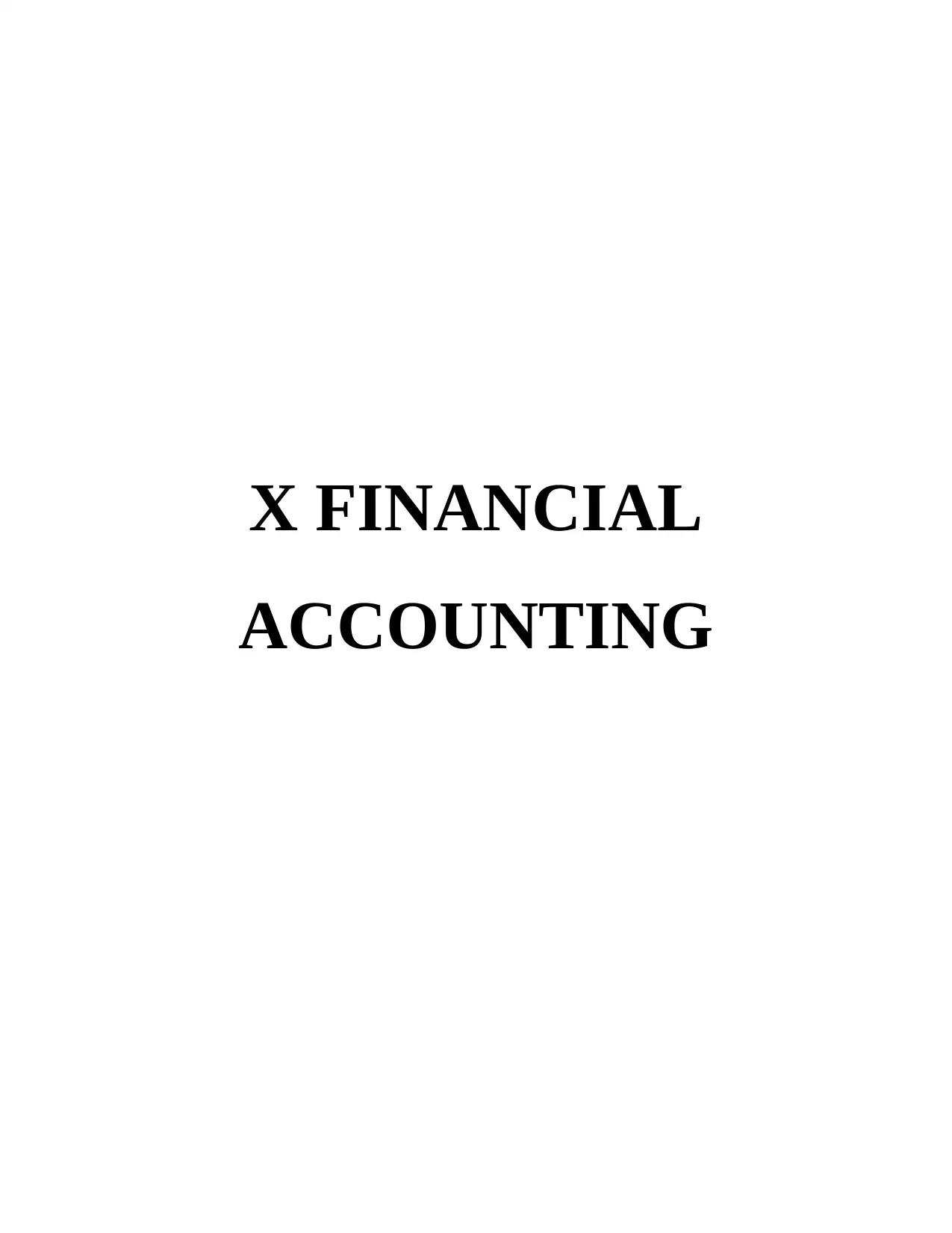
X FINANCIAL
ACCOUNTING
ACCOUNTING
Secure Best Marks with AI Grader
Need help grading? Try our AI Grader for instant feedback on your assignments.
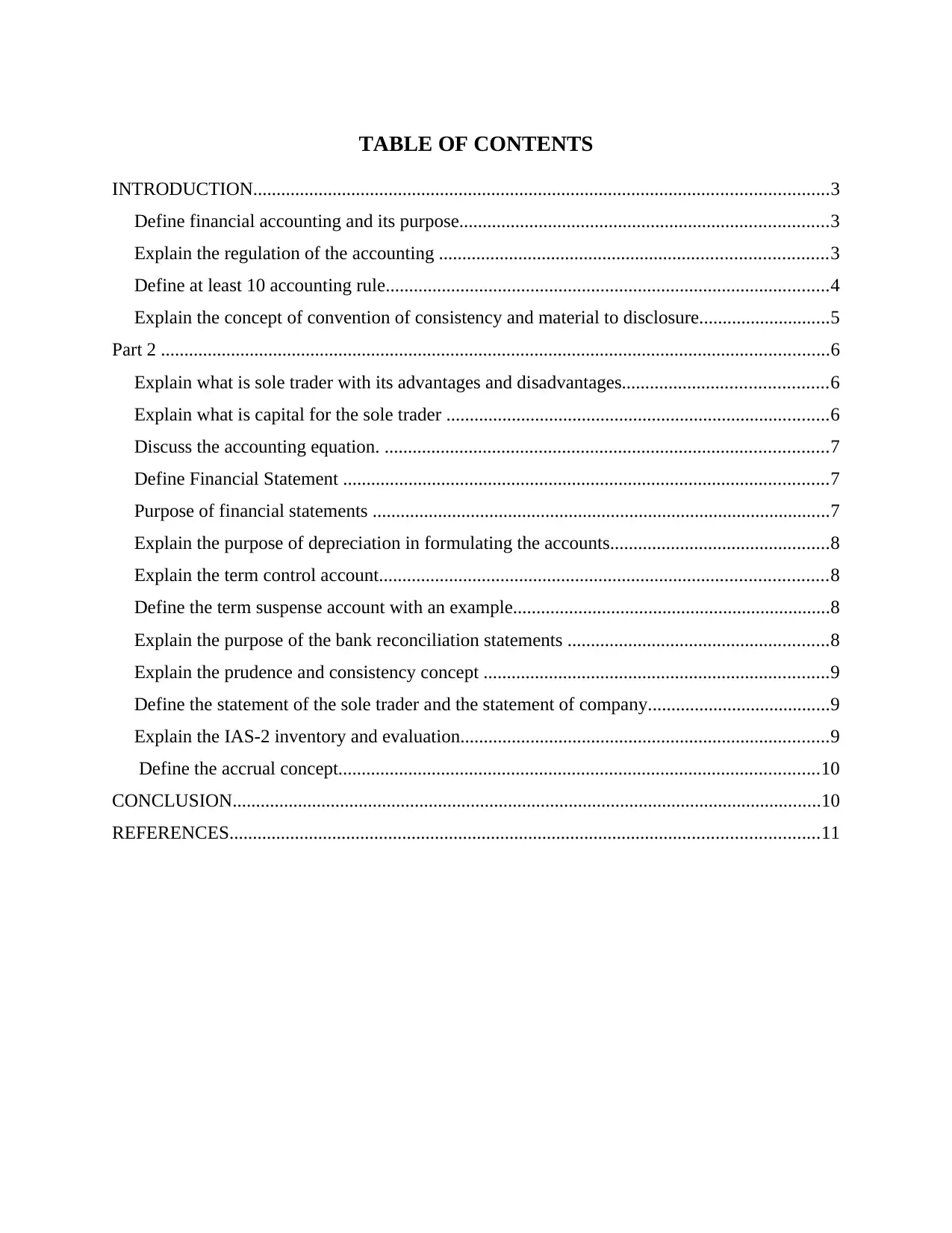
TABLE OF CONTENTS
INTRODUCTION...........................................................................................................................3
Define financial accounting and its purpose...............................................................................3
Explain the regulation of the accounting ...................................................................................3
Define at least 10 accounting rule...............................................................................................4
Explain the concept of convention of consistency and material to disclosure............................5
Part 2 ...............................................................................................................................................6
Explain what is sole trader with its advantages and disadvantages............................................6
Explain what is capital for the sole trader ..................................................................................6
Discuss the accounting equation. ...............................................................................................7
Define Financial Statement ........................................................................................................7
Purpose of financial statements ..................................................................................................7
Explain the purpose of depreciation in formulating the accounts...............................................8
Explain the term control account................................................................................................8
Define the term suspense account with an example....................................................................8
Explain the purpose of the bank reconciliation statements ........................................................8
Explain the prudence and consistency concept ..........................................................................9
Define the statement of the sole trader and the statement of company.......................................9
Explain the IAS-2 inventory and evaluation...............................................................................9
Define the accrual concept.......................................................................................................10
CONCLUSION..............................................................................................................................10
REFERENCES..............................................................................................................................11
INTRODUCTION...........................................................................................................................3
Define financial accounting and its purpose...............................................................................3
Explain the regulation of the accounting ...................................................................................3
Define at least 10 accounting rule...............................................................................................4
Explain the concept of convention of consistency and material to disclosure............................5
Part 2 ...............................................................................................................................................6
Explain what is sole trader with its advantages and disadvantages............................................6
Explain what is capital for the sole trader ..................................................................................6
Discuss the accounting equation. ...............................................................................................7
Define Financial Statement ........................................................................................................7
Purpose of financial statements ..................................................................................................7
Explain the purpose of depreciation in formulating the accounts...............................................8
Explain the term control account................................................................................................8
Define the term suspense account with an example....................................................................8
Explain the purpose of the bank reconciliation statements ........................................................8
Explain the prudence and consistency concept ..........................................................................9
Define the statement of the sole trader and the statement of company.......................................9
Explain the IAS-2 inventory and evaluation...............................................................................9
Define the accrual concept.......................................................................................................10
CONCLUSION..............................................................................................................................10
REFERENCES..............................................................................................................................11
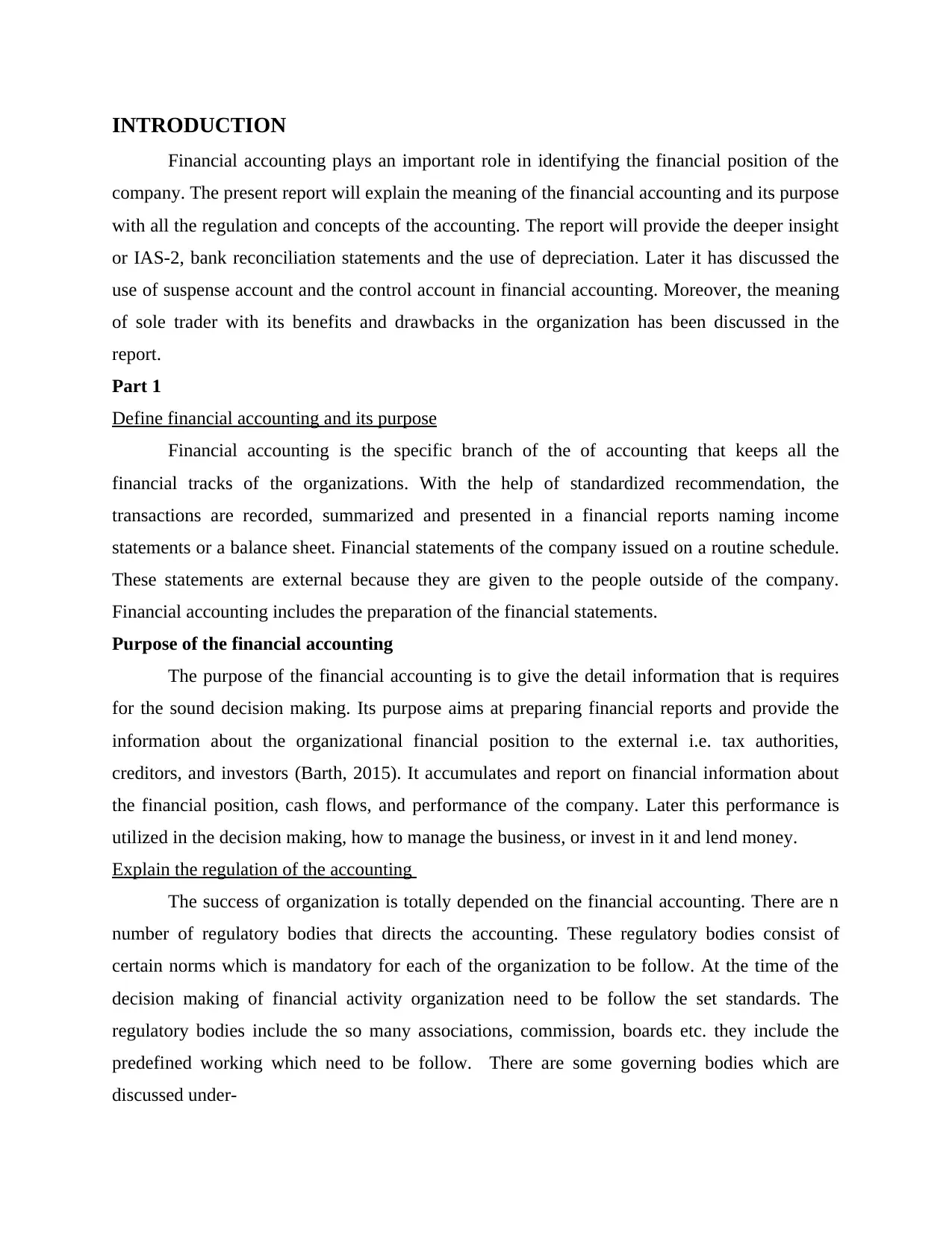
INTRODUCTION
Financial accounting plays an important role in identifying the financial position of the
company. The present report will explain the meaning of the financial accounting and its purpose
with all the regulation and concepts of the accounting. The report will provide the deeper insight
or IAS-2, bank reconciliation statements and the use of depreciation. Later it has discussed the
use of suspense account and the control account in financial accounting. Moreover, the meaning
of sole trader with its benefits and drawbacks in the organization has been discussed in the
report.
Part 1
Define financial accounting and its purpose
Financial accounting is the specific branch of the of accounting that keeps all the
financial tracks of the organizations. With the help of standardized recommendation, the
transactions are recorded, summarized and presented in a financial reports naming income
statements or a balance sheet. Financial statements of the company issued on a routine schedule.
These statements are external because they are given to the people outside of the company.
Financial accounting includes the preparation of the financial statements.
Purpose of the financial accounting
The purpose of the financial accounting is to give the detail information that is requires
for the sound decision making. Its purpose aims at preparing financial reports and provide the
information about the organizational financial position to the external i.e. tax authorities,
creditors, and investors (Barth, 2015). It accumulates and report on financial information about
the financial position, cash flows, and performance of the company. Later this performance is
utilized in the decision making, how to manage the business, or invest in it and lend money.
Explain the regulation of the accounting
The success of organization is totally depended on the financial accounting. There are n
number of regulatory bodies that directs the accounting. These regulatory bodies consist of
certain norms which is mandatory for each of the organization to be follow. At the time of the
decision making of financial activity organization need to be follow the set standards. The
regulatory bodies include the so many associations, commission, boards etc. they include the
predefined working which need to be follow. There are some governing bodies which are
discussed under-
Financial accounting plays an important role in identifying the financial position of the
company. The present report will explain the meaning of the financial accounting and its purpose
with all the regulation and concepts of the accounting. The report will provide the deeper insight
or IAS-2, bank reconciliation statements and the use of depreciation. Later it has discussed the
use of suspense account and the control account in financial accounting. Moreover, the meaning
of sole trader with its benefits and drawbacks in the organization has been discussed in the
report.
Part 1
Define financial accounting and its purpose
Financial accounting is the specific branch of the of accounting that keeps all the
financial tracks of the organizations. With the help of standardized recommendation, the
transactions are recorded, summarized and presented in a financial reports naming income
statements or a balance sheet. Financial statements of the company issued on a routine schedule.
These statements are external because they are given to the people outside of the company.
Financial accounting includes the preparation of the financial statements.
Purpose of the financial accounting
The purpose of the financial accounting is to give the detail information that is requires
for the sound decision making. Its purpose aims at preparing financial reports and provide the
information about the organizational financial position to the external i.e. tax authorities,
creditors, and investors (Barth, 2015). It accumulates and report on financial information about
the financial position, cash flows, and performance of the company. Later this performance is
utilized in the decision making, how to manage the business, or invest in it and lend money.
Explain the regulation of the accounting
The success of organization is totally depended on the financial accounting. There are n
number of regulatory bodies that directs the accounting. These regulatory bodies consist of
certain norms which is mandatory for each of the organization to be follow. At the time of the
decision making of financial activity organization need to be follow the set standards. The
regulatory bodies include the so many associations, commission, boards etc. they include the
predefined working which need to be follow. There are some governing bodies which are
discussed under-
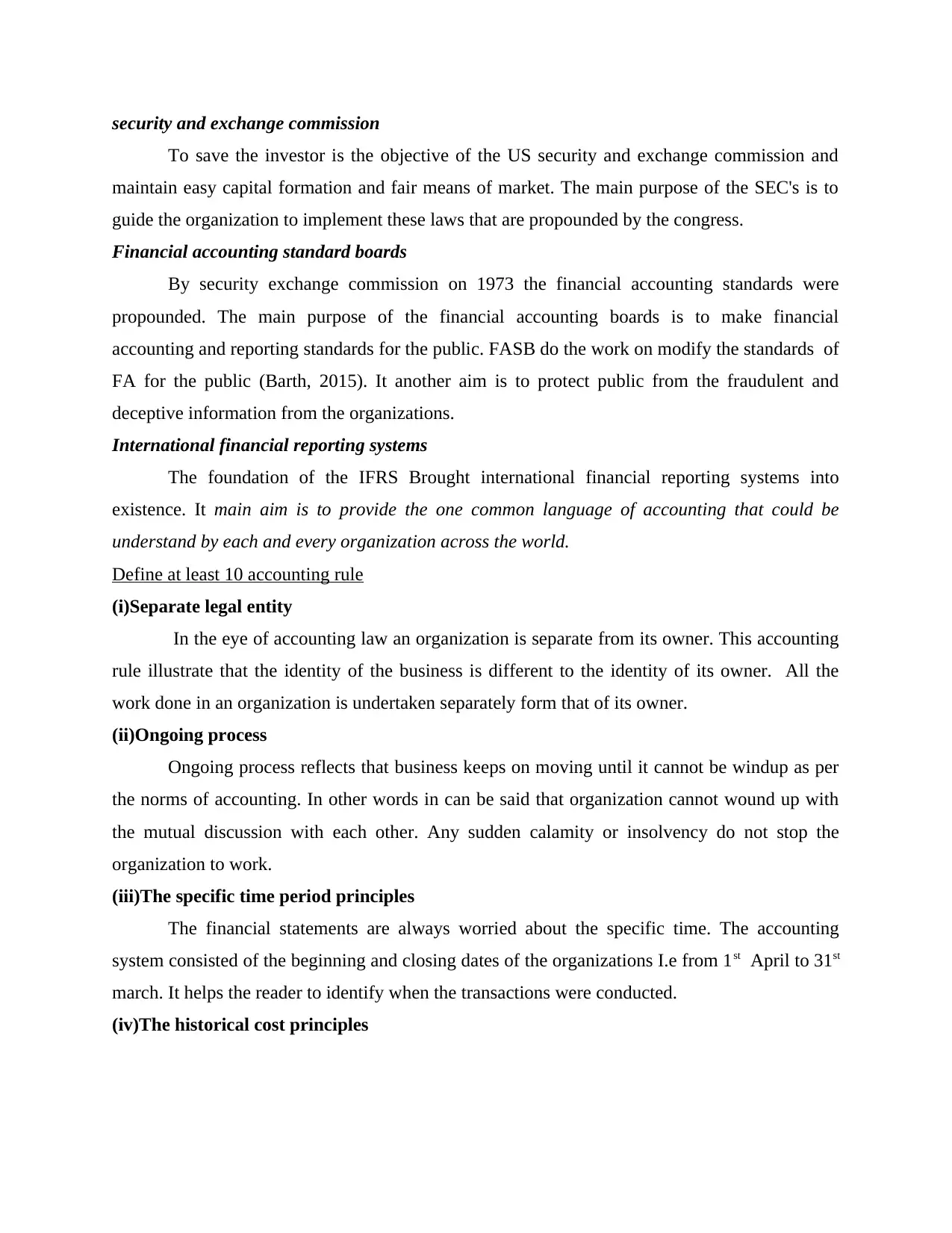
security and exchange commission
To save the investor is the objective of the US security and exchange commission and
maintain easy capital formation and fair means of market. The main purpose of the SEC's is to
guide the organization to implement these laws that are propounded by the congress.
Financial accounting standard boards
By security exchange commission on 1973 the financial accounting standards were
propounded. The main purpose of the financial accounting boards is to make financial
accounting and reporting standards for the public. FASB do the work on modify the standards of
FA for the public (Barth, 2015). It another aim is to protect public from the fraudulent and
deceptive information from the organizations.
International financial reporting systems
The foundation of the IFRS Brought international financial reporting systems into
existence. It main aim is to provide the one common language of accounting that could be
understand by each and every organization across the world.
Define at least 10 accounting rule
(i)Separate legal entity
In the eye of accounting law an organization is separate from its owner. This accounting
rule illustrate that the identity of the business is different to the identity of its owner. All the
work done in an organization is undertaken separately form that of its owner.
(ii)Ongoing process
Ongoing process reflects that business keeps on moving until it cannot be windup as per
the norms of accounting. In other words in can be said that organization cannot wound up with
the mutual discussion with each other. Any sudden calamity or insolvency do not stop the
organization to work.
(iii)The specific time period principles
The financial statements are always worried about the specific time. The accounting
system consisted of the beginning and closing dates of the organizations I.e from 1st April to 31st
march. It helps the reader to identify when the transactions were conducted.
(iv)The historical cost principles
To save the investor is the objective of the US security and exchange commission and
maintain easy capital formation and fair means of market. The main purpose of the SEC's is to
guide the organization to implement these laws that are propounded by the congress.
Financial accounting standard boards
By security exchange commission on 1973 the financial accounting standards were
propounded. The main purpose of the financial accounting boards is to make financial
accounting and reporting standards for the public. FASB do the work on modify the standards of
FA for the public (Barth, 2015). It another aim is to protect public from the fraudulent and
deceptive information from the organizations.
International financial reporting systems
The foundation of the IFRS Brought international financial reporting systems into
existence. It main aim is to provide the one common language of accounting that could be
understand by each and every organization across the world.
Define at least 10 accounting rule
(i)Separate legal entity
In the eye of accounting law an organization is separate from its owner. This accounting
rule illustrate that the identity of the business is different to the identity of its owner. All the
work done in an organization is undertaken separately form that of its owner.
(ii)Ongoing process
Ongoing process reflects that business keeps on moving until it cannot be windup as per
the norms of accounting. In other words in can be said that organization cannot wound up with
the mutual discussion with each other. Any sudden calamity or insolvency do not stop the
organization to work.
(iii)The specific time period principles
The financial statements are always worried about the specific time. The accounting
system consisted of the beginning and closing dates of the organizations I.e from 1st April to 31st
march. It helps the reader to identify when the transactions were conducted.
(iv)The historical cost principles
Secure Best Marks with AI Grader
Need help grading? Try our AI Grader for instant feedback on your assignments.
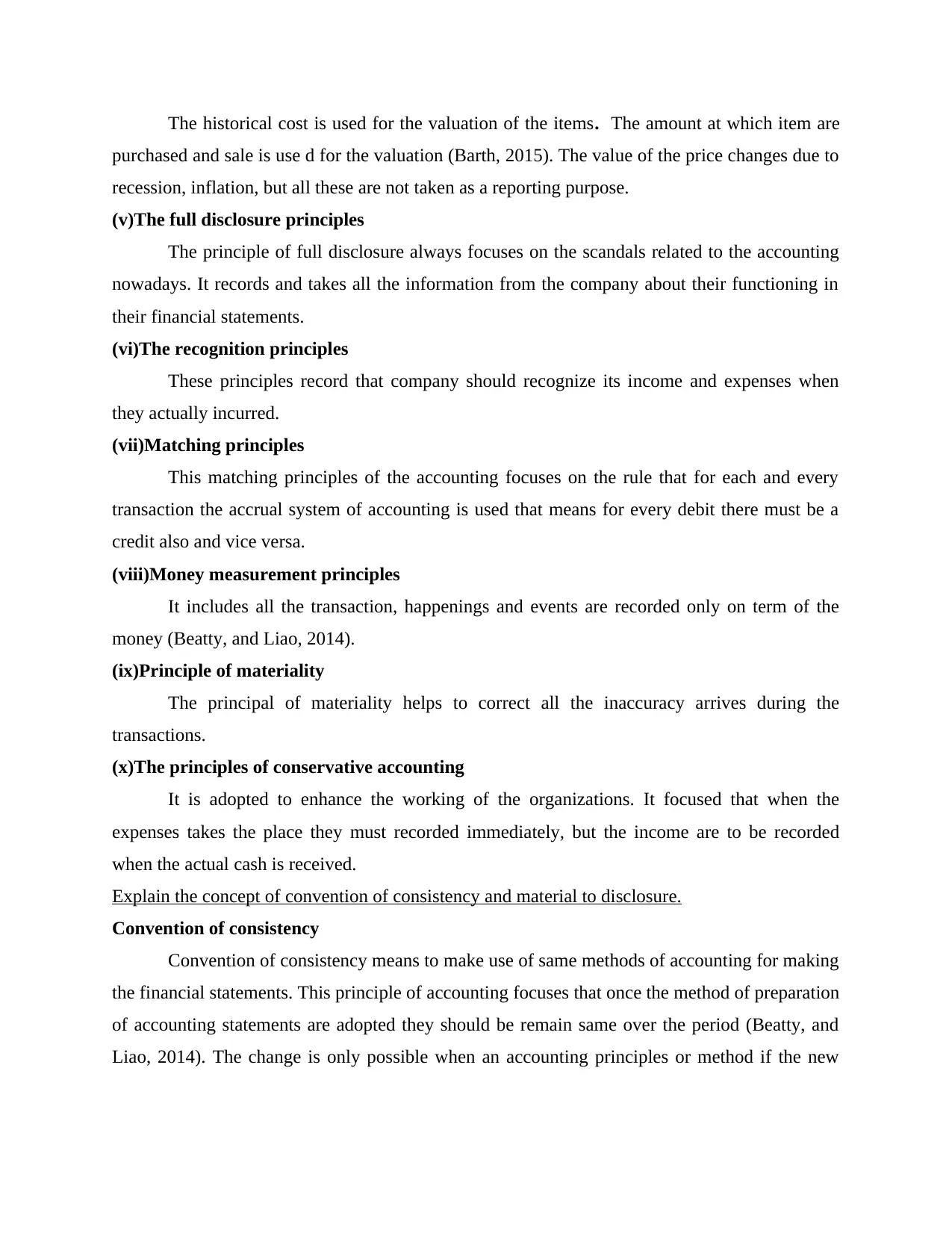
The historical cost is used for the valuation of the items. The amount at which item are
purchased and sale is use d for the valuation (Barth, 2015). The value of the price changes due to
recession, inflation, but all these are not taken as a reporting purpose.
(v)The full disclosure principles
The principle of full disclosure always focuses on the scandals related to the accounting
nowadays. It records and takes all the information from the company about their functioning in
their financial statements.
(vi)The recognition principles
These principles record that company should recognize its income and expenses when
they actually incurred.
(vii)Matching principles
This matching principles of the accounting focuses on the rule that for each and every
transaction the accrual system of accounting is used that means for every debit there must be a
credit also and vice versa.
(viii)Money measurement principles
It includes all the transaction, happenings and events are recorded only on term of the
money (Beatty, and Liao, 2014).
(ix)Principle of materiality
The principal of materiality helps to correct all the inaccuracy arrives during the
transactions.
(x)The principles of conservative accounting
It is adopted to enhance the working of the organizations. It focused that when the
expenses takes the place they must recorded immediately, but the income are to be recorded
when the actual cash is received.
Explain the concept of convention of consistency and material to disclosure.
Convention of consistency
Convention of consistency means to make use of same methods of accounting for making
the financial statements. This principle of accounting focuses that once the method of preparation
of accounting statements are adopted they should be remain same over the period (Beatty, and
Liao, 2014). The change is only possible when an accounting principles or method if the new
purchased and sale is use d for the valuation (Barth, 2015). The value of the price changes due to
recession, inflation, but all these are not taken as a reporting purpose.
(v)The full disclosure principles
The principle of full disclosure always focuses on the scandals related to the accounting
nowadays. It records and takes all the information from the company about their functioning in
their financial statements.
(vi)The recognition principles
These principles record that company should recognize its income and expenses when
they actually incurred.
(vii)Matching principles
This matching principles of the accounting focuses on the rule that for each and every
transaction the accrual system of accounting is used that means for every debit there must be a
credit also and vice versa.
(viii)Money measurement principles
It includes all the transaction, happenings and events are recorded only on term of the
money (Beatty, and Liao, 2014).
(ix)Principle of materiality
The principal of materiality helps to correct all the inaccuracy arrives during the
transactions.
(x)The principles of conservative accounting
It is adopted to enhance the working of the organizations. It focused that when the
expenses takes the place they must recorded immediately, but the income are to be recorded
when the actual cash is received.
Explain the concept of convention of consistency and material to disclosure.
Convention of consistency
Convention of consistency means to make use of same methods of accounting for making
the financial statements. This principle of accounting focuses that once the method of preparation
of accounting statements are adopted they should be remain same over the period (Beatty, and
Liao, 2014). The change is only possible when an accounting principles or method if the new
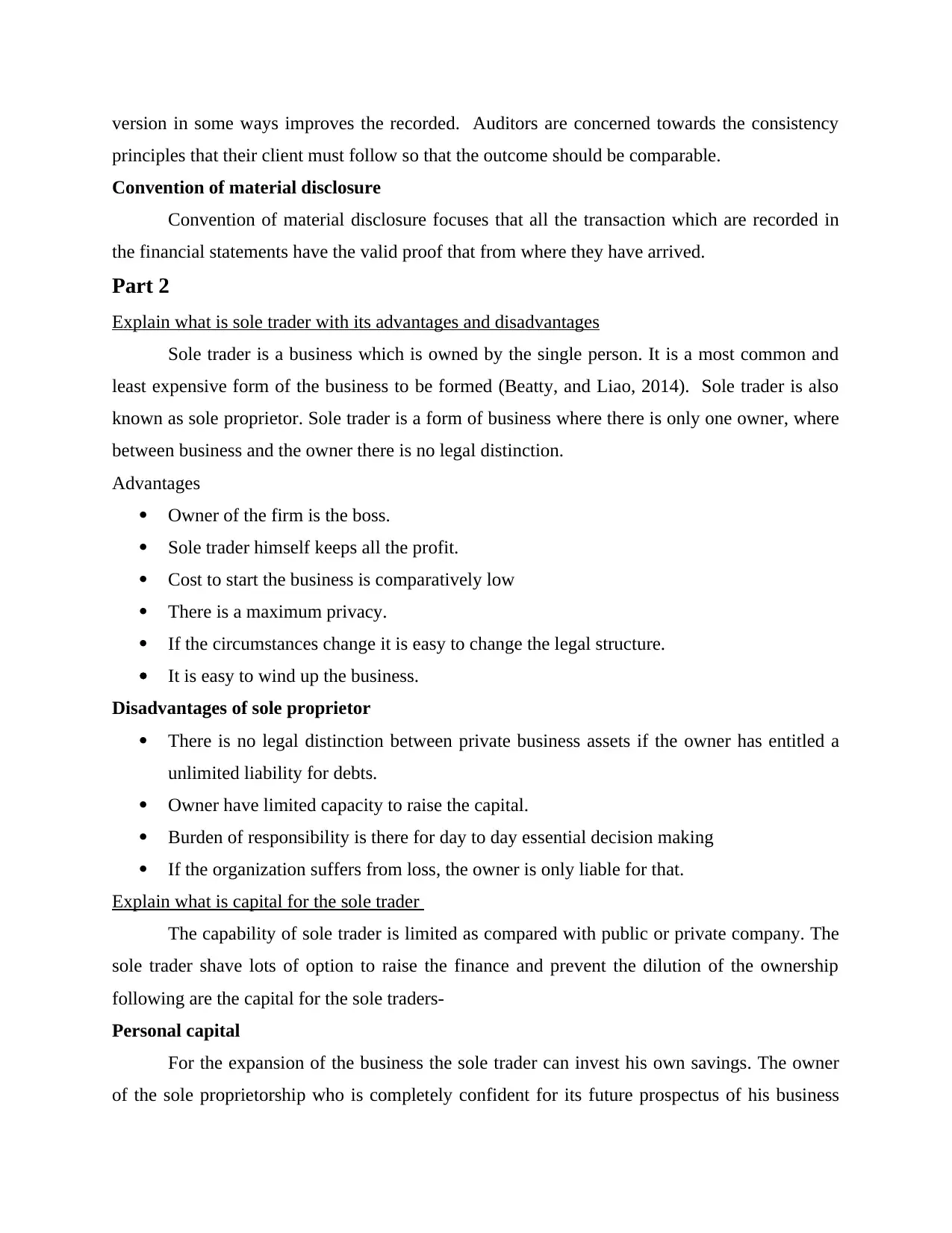
version in some ways improves the recorded. Auditors are concerned towards the consistency
principles that their client must follow so that the outcome should be comparable.
Convention of material disclosure
Convention of material disclosure focuses that all the transaction which are recorded in
the financial statements have the valid proof that from where they have arrived.
Part 2
Explain what is sole trader with its advantages and disadvantages
Sole trader is a business which is owned by the single person. It is a most common and
least expensive form of the business to be formed (Beatty, and Liao, 2014). Sole trader is also
known as sole proprietor. Sole trader is a form of business where there is only one owner, where
between business and the owner there is no legal distinction.
Advantages
Owner of the firm is the boss.
Sole trader himself keeps all the profit.
Cost to start the business is comparatively low
There is a maximum privacy.
If the circumstances change it is easy to change the legal structure.
It is easy to wind up the business.
Disadvantages of sole proprietor
There is no legal distinction between private business assets if the owner has entitled a
unlimited liability for debts.
Owner have limited capacity to raise the capital.
Burden of responsibility is there for day to day essential decision making
If the organization suffers from loss, the owner is only liable for that.
Explain what is capital for the sole trader
The capability of sole trader is limited as compared with public or private company. The
sole trader shave lots of option to raise the finance and prevent the dilution of the ownership
following are the capital for the sole traders-
Personal capital
For the expansion of the business the sole trader can invest his own savings. The owner
of the sole proprietorship who is completely confident for its future prospectus of his business
principles that their client must follow so that the outcome should be comparable.
Convention of material disclosure
Convention of material disclosure focuses that all the transaction which are recorded in
the financial statements have the valid proof that from where they have arrived.
Part 2
Explain what is sole trader with its advantages and disadvantages
Sole trader is a business which is owned by the single person. It is a most common and
least expensive form of the business to be formed (Beatty, and Liao, 2014). Sole trader is also
known as sole proprietor. Sole trader is a form of business where there is only one owner, where
between business and the owner there is no legal distinction.
Advantages
Owner of the firm is the boss.
Sole trader himself keeps all the profit.
Cost to start the business is comparatively low
There is a maximum privacy.
If the circumstances change it is easy to change the legal structure.
It is easy to wind up the business.
Disadvantages of sole proprietor
There is no legal distinction between private business assets if the owner has entitled a
unlimited liability for debts.
Owner have limited capacity to raise the capital.
Burden of responsibility is there for day to day essential decision making
If the organization suffers from loss, the owner is only liable for that.
Explain what is capital for the sole trader
The capability of sole trader is limited as compared with public or private company. The
sole trader shave lots of option to raise the finance and prevent the dilution of the ownership
following are the capital for the sole traders-
Personal capital
For the expansion of the business the sole trader can invest his own savings. The owner
of the sole proprietorship who is completely confident for its future prospectus of his business
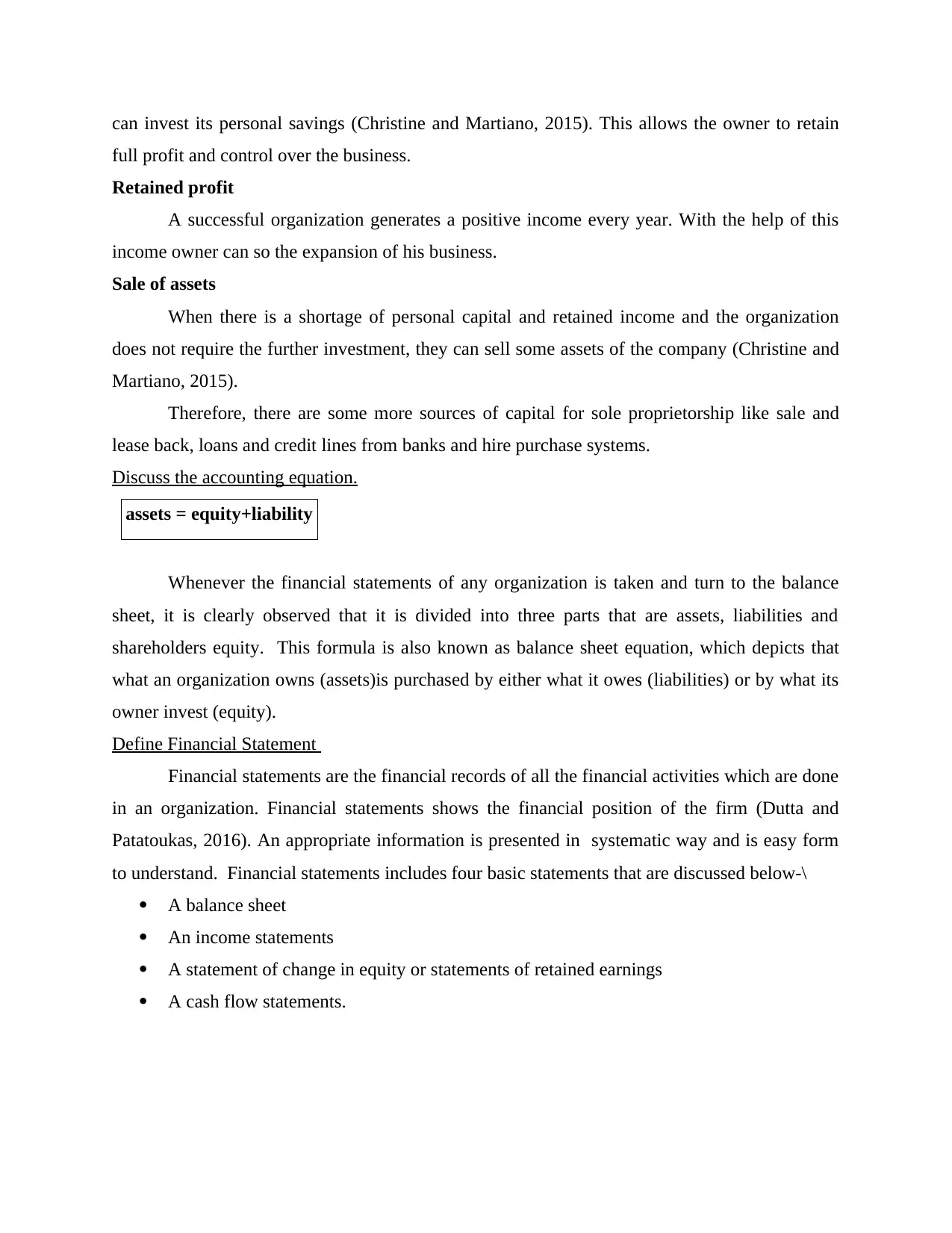
can invest its personal savings (Christine and Martiano, 2015). This allows the owner to retain
full profit and control over the business.
Retained profit
A successful organization generates a positive income every year. With the help of this
income owner can so the expansion of his business.
Sale of assets
When there is a shortage of personal capital and retained income and the organization
does not require the further investment, they can sell some assets of the company (Christine and
Martiano, 2015).
Therefore, there are some more sources of capital for sole proprietorship like sale and
lease back, loans and credit lines from banks and hire purchase systems.
Discuss the accounting equation.
assets = equity+liability
Whenever the financial statements of any organization is taken and turn to the balance
sheet, it is clearly observed that it is divided into three parts that are assets, liabilities and
shareholders equity. This formula is also known as balance sheet equation, which depicts that
what an organization owns (assets)is purchased by either what it owes (liabilities) or by what its
owner invest (equity).
Define Financial Statement
Financial statements are the financial records of all the financial activities which are done
in an organization. Financial statements shows the financial position of the firm (Dutta and
Patatoukas, 2016). An appropriate information is presented in systematic way and is easy form
to understand. Financial statements includes four basic statements that are discussed below-\
A balance sheet
An income statements
A statement of change in equity or statements of retained earnings
A cash flow statements.
full profit and control over the business.
Retained profit
A successful organization generates a positive income every year. With the help of this
income owner can so the expansion of his business.
Sale of assets
When there is a shortage of personal capital and retained income and the organization
does not require the further investment, they can sell some assets of the company (Christine and
Martiano, 2015).
Therefore, there are some more sources of capital for sole proprietorship like sale and
lease back, loans and credit lines from banks and hire purchase systems.
Discuss the accounting equation.
assets = equity+liability
Whenever the financial statements of any organization is taken and turn to the balance
sheet, it is clearly observed that it is divided into three parts that are assets, liabilities and
shareholders equity. This formula is also known as balance sheet equation, which depicts that
what an organization owns (assets)is purchased by either what it owes (liabilities) or by what its
owner invest (equity).
Define Financial Statement
Financial statements are the financial records of all the financial activities which are done
in an organization. Financial statements shows the financial position of the firm (Dutta and
Patatoukas, 2016). An appropriate information is presented in systematic way and is easy form
to understand. Financial statements includes four basic statements that are discussed below-\
A balance sheet
An income statements
A statement of change in equity or statements of retained earnings
A cash flow statements.
Paraphrase This Document
Need a fresh take? Get an instant paraphrase of this document with our AI Paraphraser
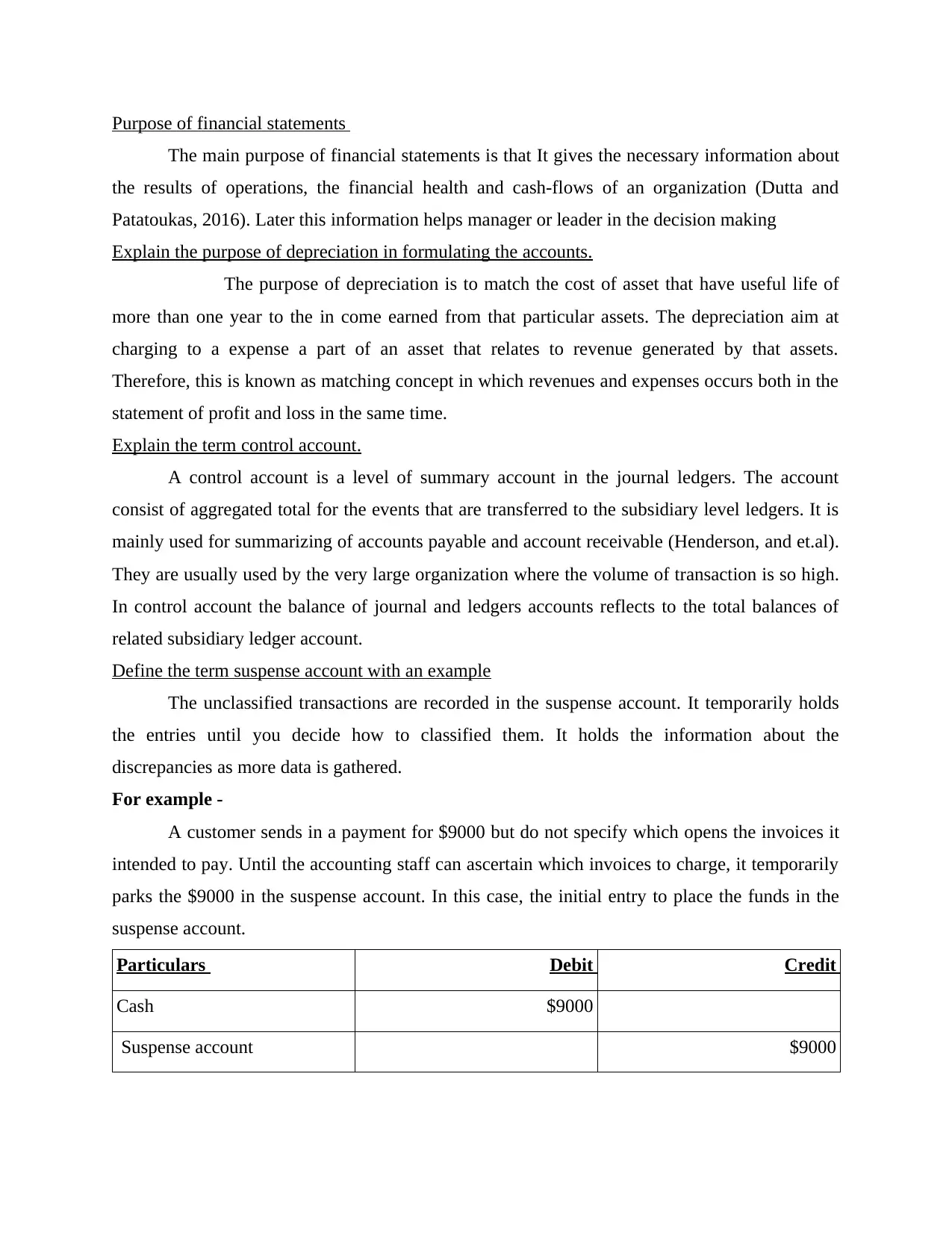
Purpose of financial statements
The main purpose of financial statements is that It gives the necessary information about
the results of operations, the financial health and cash-flows of an organization (Dutta and
Patatoukas, 2016). Later this information helps manager or leader in the decision making
Explain the purpose of depreciation in formulating the accounts.
The purpose of depreciation is to match the cost of asset that have useful life of
more than one year to the in come earned from that particular assets. The depreciation aim at
charging to a expense a part of an asset that relates to revenue generated by that assets.
Therefore, this is known as matching concept in which revenues and expenses occurs both in the
statement of profit and loss in the same time.
Explain the term control account.
A control account is a level of summary account in the journal ledgers. The account
consist of aggregated total for the events that are transferred to the subsidiary level ledgers. It is
mainly used for summarizing of accounts payable and account receivable (Henderson, and et.al).
They are usually used by the very large organization where the volume of transaction is so high.
In control account the balance of journal and ledgers accounts reflects to the total balances of
related subsidiary ledger account.
Define the term suspense account with an example
The unclassified transactions are recorded in the suspense account. It temporarily holds
the entries until you decide how to classified them. It holds the information about the
discrepancies as more data is gathered.
For example -
A customer sends in a payment for $9000 but do not specify which opens the invoices it
intended to pay. Until the accounting staff can ascertain which invoices to charge, it temporarily
parks the $9000 in the suspense account. In this case, the initial entry to place the funds in the
suspense account.
Particulars Debit Credit
Cash $9000
Suspense account $9000
The main purpose of financial statements is that It gives the necessary information about
the results of operations, the financial health and cash-flows of an organization (Dutta and
Patatoukas, 2016). Later this information helps manager or leader in the decision making
Explain the purpose of depreciation in formulating the accounts.
The purpose of depreciation is to match the cost of asset that have useful life of
more than one year to the in come earned from that particular assets. The depreciation aim at
charging to a expense a part of an asset that relates to revenue generated by that assets.
Therefore, this is known as matching concept in which revenues and expenses occurs both in the
statement of profit and loss in the same time.
Explain the term control account.
A control account is a level of summary account in the journal ledgers. The account
consist of aggregated total for the events that are transferred to the subsidiary level ledgers. It is
mainly used for summarizing of accounts payable and account receivable (Henderson, and et.al).
They are usually used by the very large organization where the volume of transaction is so high.
In control account the balance of journal and ledgers accounts reflects to the total balances of
related subsidiary ledger account.
Define the term suspense account with an example
The unclassified transactions are recorded in the suspense account. It temporarily holds
the entries until you decide how to classified them. It holds the information about the
discrepancies as more data is gathered.
For example -
A customer sends in a payment for $9000 but do not specify which opens the invoices it
intended to pay. Until the accounting staff can ascertain which invoices to charge, it temporarily
parks the $9000 in the suspense account. In this case, the initial entry to place the funds in the
suspense account.
Particulars Debit Credit
Cash $9000
Suspense account $9000
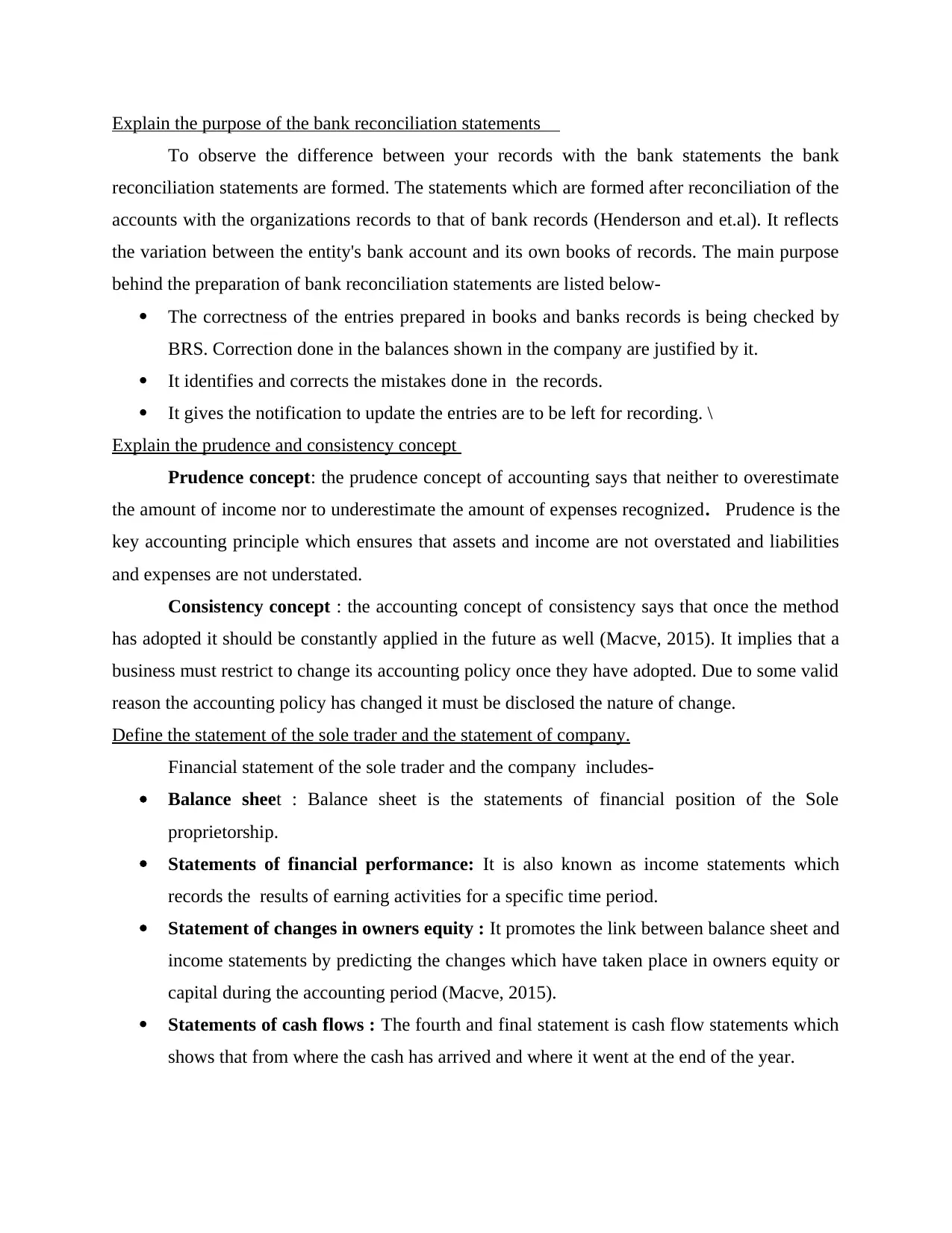
Explain the purpose of the bank reconciliation statements
To observe the difference between your records with the bank statements the bank
reconciliation statements are formed. The statements which are formed after reconciliation of the
accounts with the organizations records to that of bank records (Henderson and et.al). It reflects
the variation between the entity's bank account and its own books of records. The main purpose
behind the preparation of bank reconciliation statements are listed below-
The correctness of the entries prepared in books and banks records is being checked by
BRS. Correction done in the balances shown in the company are justified by it.
It identifies and corrects the mistakes done in the records.
It gives the notification to update the entries are to be left for recording. \
Explain the prudence and consistency concept
Prudence concept: the prudence concept of accounting says that neither to overestimate
the amount of income nor to underestimate the amount of expenses recognized. Prudence is the
key accounting principle which ensures that assets and income are not overstated and liabilities
and expenses are not understated.
Consistency concept : the accounting concept of consistency says that once the method
has adopted it should be constantly applied in the future as well (Macve, 2015). It implies that a
business must restrict to change its accounting policy once they have adopted. Due to some valid
reason the accounting policy has changed it must be disclosed the nature of change.
Define the statement of the sole trader and the statement of company.
Financial statement of the sole trader and the company includes-
Balance sheet : Balance sheet is the statements of financial position of the Sole
proprietorship.
Statements of financial performance: It is also known as income statements which
records the results of earning activities for a specific time period.
Statement of changes in owners equity : It promotes the link between balance sheet and
income statements by predicting the changes which have taken place in owners equity or
capital during the accounting period (Macve, 2015).
Statements of cash flows : The fourth and final statement is cash flow statements which
shows that from where the cash has arrived and where it went at the end of the year.
To observe the difference between your records with the bank statements the bank
reconciliation statements are formed. The statements which are formed after reconciliation of the
accounts with the organizations records to that of bank records (Henderson and et.al). It reflects
the variation between the entity's bank account and its own books of records. The main purpose
behind the preparation of bank reconciliation statements are listed below-
The correctness of the entries prepared in books and banks records is being checked by
BRS. Correction done in the balances shown in the company are justified by it.
It identifies and corrects the mistakes done in the records.
It gives the notification to update the entries are to be left for recording. \
Explain the prudence and consistency concept
Prudence concept: the prudence concept of accounting says that neither to overestimate
the amount of income nor to underestimate the amount of expenses recognized. Prudence is the
key accounting principle which ensures that assets and income are not overstated and liabilities
and expenses are not understated.
Consistency concept : the accounting concept of consistency says that once the method
has adopted it should be constantly applied in the future as well (Macve, 2015). It implies that a
business must restrict to change its accounting policy once they have adopted. Due to some valid
reason the accounting policy has changed it must be disclosed the nature of change.
Define the statement of the sole trader and the statement of company.
Financial statement of the sole trader and the company includes-
Balance sheet : Balance sheet is the statements of financial position of the Sole
proprietorship.
Statements of financial performance: It is also known as income statements which
records the results of earning activities for a specific time period.
Statement of changes in owners equity : It promotes the link between balance sheet and
income statements by predicting the changes which have taken place in owners equity or
capital during the accounting period (Macve, 2015).
Statements of cash flows : The fourth and final statement is cash flow statements which
shows that from where the cash has arrived and where it went at the end of the year.
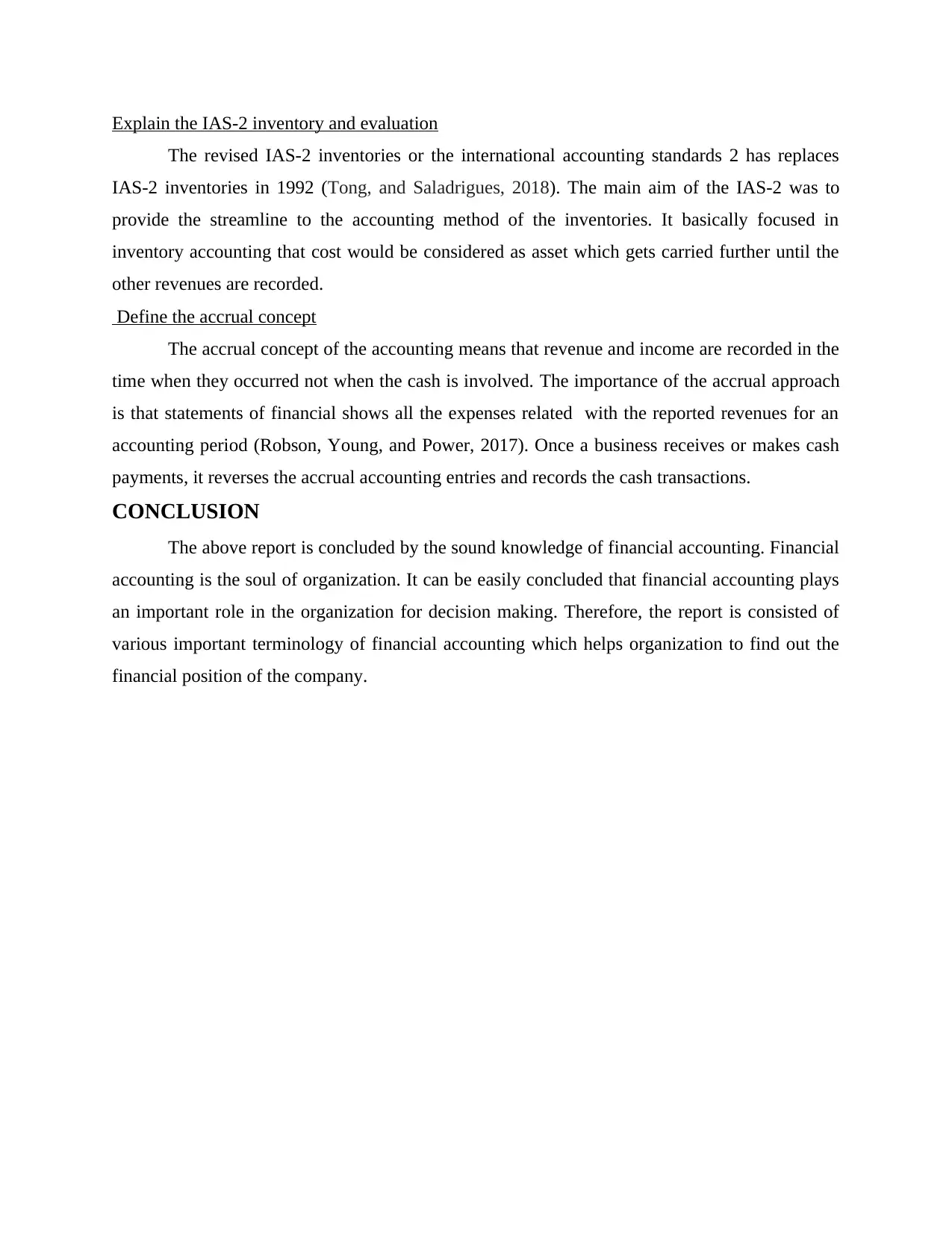
Explain the IAS-2 inventory and evaluation
The revised IAS-2 inventories or the international accounting standards 2 has replaces
IAS-2 inventories in 1992 (Tong, and Saladrigues, 2018). The main aim of the IAS-2 was to
provide the streamline to the accounting method of the inventories. It basically focused in
inventory accounting that cost would be considered as asset which gets carried further until the
other revenues are recorded.
Define the accrual concept
The accrual concept of the accounting means that revenue and income are recorded in the
time when they occurred not when the cash is involved. The importance of the accrual approach
is that statements of financial shows all the expenses related with the reported revenues for an
accounting period (Robson, Young, and Power, 2017). Once a business receives or makes cash
payments, it reverses the accrual accounting entries and records the cash transactions.
CONCLUSION
The above report is concluded by the sound knowledge of financial accounting. Financial
accounting is the soul of organization. It can be easily concluded that financial accounting plays
an important role in the organization for decision making. Therefore, the report is consisted of
various important terminology of financial accounting which helps organization to find out the
financial position of the company.
The revised IAS-2 inventories or the international accounting standards 2 has replaces
IAS-2 inventories in 1992 (Tong, and Saladrigues, 2018). The main aim of the IAS-2 was to
provide the streamline to the accounting method of the inventories. It basically focused in
inventory accounting that cost would be considered as asset which gets carried further until the
other revenues are recorded.
Define the accrual concept
The accrual concept of the accounting means that revenue and income are recorded in the
time when they occurred not when the cash is involved. The importance of the accrual approach
is that statements of financial shows all the expenses related with the reported revenues for an
accounting period (Robson, Young, and Power, 2017). Once a business receives or makes cash
payments, it reverses the accrual accounting entries and records the cash transactions.
CONCLUSION
The above report is concluded by the sound knowledge of financial accounting. Financial
accounting is the soul of organization. It can be easily concluded that financial accounting plays
an important role in the organization for decision making. Therefore, the report is consisted of
various important terminology of financial accounting which helps organization to find out the
financial position of the company.
Secure Best Marks with AI Grader
Need help grading? Try our AI Grader for instant feedback on your assignments.
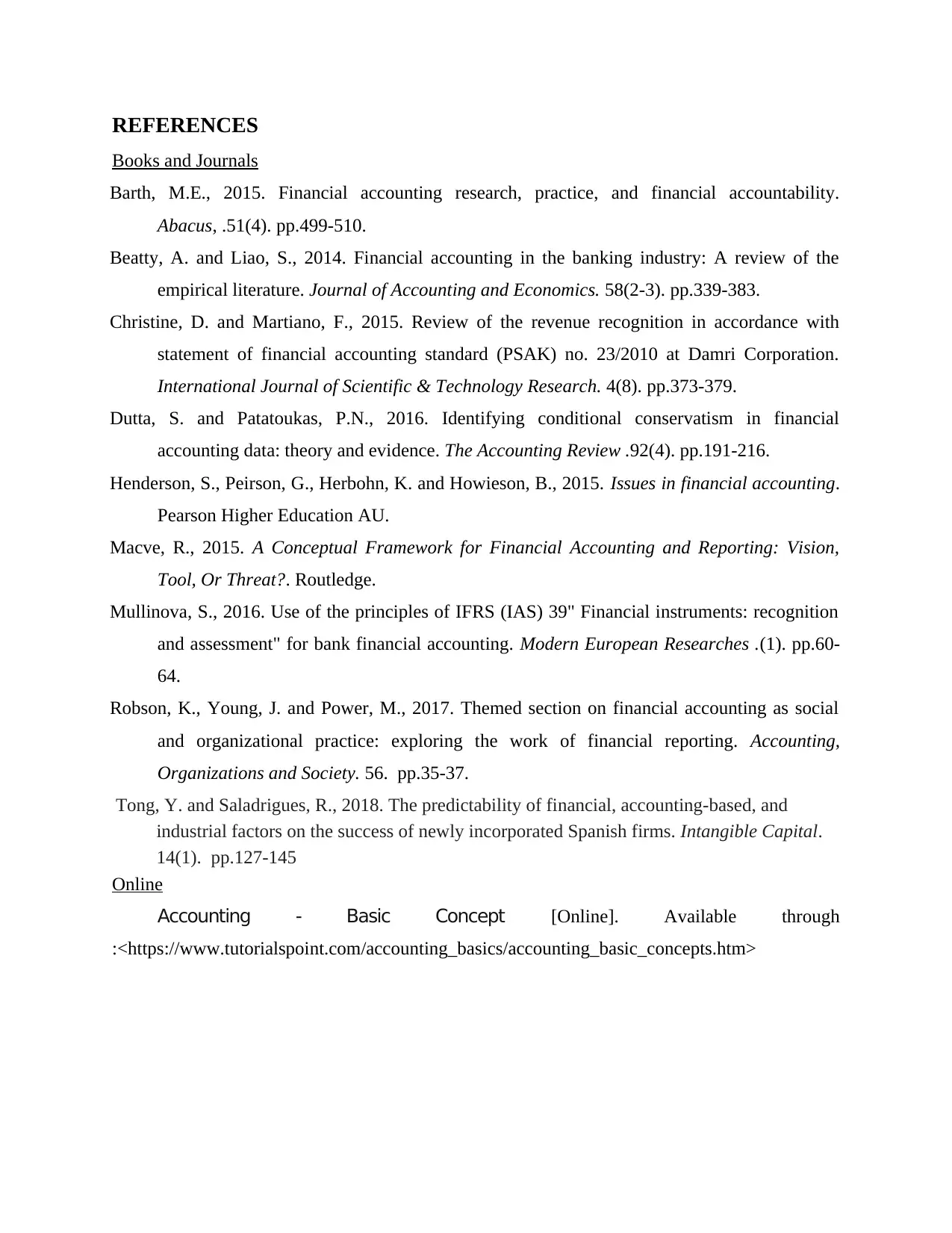
REFERENCES
Books and Journals
Barth, M.E., 2015. Financial accounting research, practice, and financial accountability.
Abacus, .51(4). pp.499-510.
Beatty, A. and Liao, S., 2014. Financial accounting in the banking industry: A review of the
empirical literature. Journal of Accounting and Economics. 58(2-3). pp.339-383.
Christine, D. and Martiano, F., 2015. Review of the revenue recognition in accordance with
statement of financial accounting standard (PSAK) no. 23/2010 at Damri Corporation.
International Journal of Scientific & Technology Research. 4(8). pp.373-379.
Dutta, S. and Patatoukas, P.N., 2016. Identifying conditional conservatism in financial
accounting data: theory and evidence. The Accounting Review .92(4). pp.191-216.
Henderson, S., Peirson, G., Herbohn, K. and Howieson, B., 2015. Issues in financial accounting.
Pearson Higher Education AU.
Macve, R., 2015. A Conceptual Framework for Financial Accounting and Reporting: Vision,
Tool, Or Threat?. Routledge.
Mullinova, S., 2016. Use of the principles of IFRS (IAS) 39" Financial instruments: recognition
and assessment" for bank financial accounting. Modern European Researches .(1). pp.60-
64.
Robson, K., Young, J. and Power, M., 2017. Themed section on financial accounting as social
and organizational practice: exploring the work of financial reporting. Accounting,
Organizations and Society. 56. pp.35-37.
Tong, Y. and Saladrigues, R., 2018. The predictability of financial, accounting-based, and
industrial factors on the success of newly incorporated Spanish firms. Intangible Capital.
14(1). pp.127-145
Online
Accounting - Basic Concept [Online]. Available through
:<https://www.tutorialspoint.com/accounting_basics/accounting_basic_concepts.htm>
Books and Journals
Barth, M.E., 2015. Financial accounting research, practice, and financial accountability.
Abacus, .51(4). pp.499-510.
Beatty, A. and Liao, S., 2014. Financial accounting in the banking industry: A review of the
empirical literature. Journal of Accounting and Economics. 58(2-3). pp.339-383.
Christine, D. and Martiano, F., 2015. Review of the revenue recognition in accordance with
statement of financial accounting standard (PSAK) no. 23/2010 at Damri Corporation.
International Journal of Scientific & Technology Research. 4(8). pp.373-379.
Dutta, S. and Patatoukas, P.N., 2016. Identifying conditional conservatism in financial
accounting data: theory and evidence. The Accounting Review .92(4). pp.191-216.
Henderson, S., Peirson, G., Herbohn, K. and Howieson, B., 2015. Issues in financial accounting.
Pearson Higher Education AU.
Macve, R., 2015. A Conceptual Framework for Financial Accounting and Reporting: Vision,
Tool, Or Threat?. Routledge.
Mullinova, S., 2016. Use of the principles of IFRS (IAS) 39" Financial instruments: recognition
and assessment" for bank financial accounting. Modern European Researches .(1). pp.60-
64.
Robson, K., Young, J. and Power, M., 2017. Themed section on financial accounting as social
and organizational practice: exploring the work of financial reporting. Accounting,
Organizations and Society. 56. pp.35-37.
Tong, Y. and Saladrigues, R., 2018. The predictability of financial, accounting-based, and
industrial factors on the success of newly incorporated Spanish firms. Intangible Capital.
14(1). pp.127-145
Online
Accounting - Basic Concept [Online]. Available through
:<https://www.tutorialspoint.com/accounting_basics/accounting_basic_concepts.htm>
1 out of 11
Related Documents
Your All-in-One AI-Powered Toolkit for Academic Success.
+13062052269
info@desklib.com
Available 24*7 on WhatsApp / Email
![[object Object]](/_next/static/media/star-bottom.7253800d.svg)
Unlock your academic potential
© 2024 | Zucol Services PVT LTD | All rights reserved.





